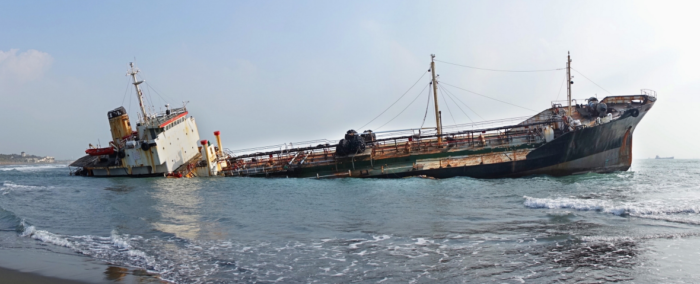The Swedish Club issued its February 2020 monthly safety scenario where a handysize bulk carrier was in ballast condition, sailing through an archipelago, while the winds were of Beaufort scale 10. The vessel eventually hit rocks, drifting on an island.
The Incident
A handysize bulk carrier was in ballast condition sailing through an archipelago during Beaufort scale 10 winds.
At the time, the vessel was passing through two islands which were creating a wind tunnel.
The third officer, acting as OOW, and a helmsman was on the bridge. The vessel was in hand steering mode and was only making 2 knots over the ground.
Because of the wind, the vessel had a hard time maintaining course and wind was blowing in on the port bow.
The helmsman had put the rudder hard to port but the vessel began to alter to starboard. Therefore, the OOW contacted the Master and informed that it was difficult to maintain course.
As stated above, the vessel was sailing between two islands, which made the winds stronger, due to the fact that the islands were creating a wind tunnel.
Then, the master went on the bridge and ordered the OOW to head to the emergency steering room, as the vessel was classed to have the engine control room constantly manned.
[smlsubform prepend=”GET THE SAFETY4SEA IN YOUR INBOX!” showname=false emailtxt=”” emailholder=”Enter your email address” showsubmit=true submittxt=”Submit” jsthanks=false thankyou=”Thank you for subscribing to our mailing list”]
Then, the master contacted the duty engineer and asked for the engine controls to be transferred to the bridge. By doing so, the engine had to be put on standby.
The master made an announcement on the PA system and called all crew to come to the bridge, while the chief officer was instructed to prepare the anchors.
Moreover, the OOW confirmed in the steering gear that the rudder was hard to port.
Similarly, yhe Chief Officer informed the Master that it was impossible to enter the main deck as large waves were washing over the deck
The duty engineer called the Master and informed him that the bridge now had the engine controls. However, the vessel had drifted very close to an island during the engine transfer. Before the Master managed to increase the engine speed the vessel hit rocks.
In light of the incident presented above, the Swedish Club highlights that operators should take into consideration the following questions.
- What were the immediate causes of this accident?
- Is there a risk that this kind of accident could happen on our vessel?
- How could this accident have been prevented?
- Discuss the decision to transfer the engine controls to the bridge and put the engines on standby.
- What are our Heavy Weather procedures?
- According to our procedures what should we have done?
- Should we ballast in a situation like this?
- What sections of our SMS would have been breached if any?
- Does our SMS address these risks?
- How could we improve our SMS to address these issues?
- What do you think was the root cause of this accident?
- Is there any kind of training that we should do that addresses these issues?
See also:
- January’s safety scenario: Lessons Learned: Improper cooperation leads to grounding
- December’s safety scenario: Mooring operation heavily injures crew






























































